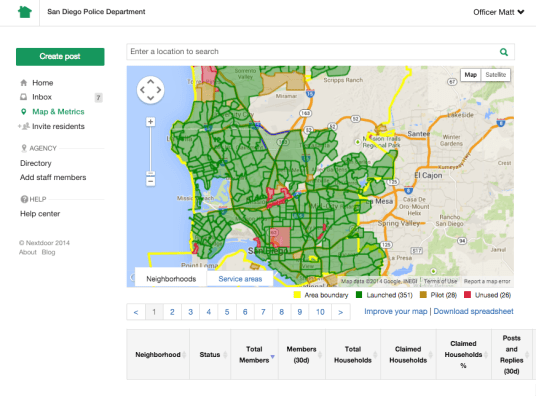Nextdoor was founded with the idea of creating a way for users to connect with their neighbors online. So the platform emerged to help community members share information about what’s going on in their neighborhoods. Today it’s taking that a step further by enabling public agencies to sign up and interact with residents.
Since being founded, the company has added nearly 43,000 neighborhoods across the country. And people have used Nextdoor in a variety of ways: to announce yard sales or sell used goods, to find local handymen or babysitters, or to keep residents aware of public issues that are being discussed or debated in their neighborhood.
But one of Nextdoor’s most important use cases has been to share local crime and safety information among residents. According to Nextdoor co-founder Sarah Leary, about 20 percent of all messages fall into that Crime & Safety bucket, with users discussing issues like break-ins in the neighborhood or other crimes that they’ve either been a victim of or witness to.
Until recently, users were mostly just talking amongst themselves, but over the last year Nextdoor has been working to help government agencies and public officials join in a way that will help them respond to Crime & Safety information shared on the platform, while also engaging with residents.
With that in mind, Nextdoor brought on members of local police departments, sheriff’s offices, fire departments, and other emergency response agencies to the platform. Working with agencies in more than 250 municipalities around the country, Nextdoor has provided them access to users in a way that would maintain the privacy of residents while ensuring that the agencies themselves aren’t inundated with information not relevant to them. For the most part, that meant limiting their access to only messages that are related to crime, safety, and emergency preparedness.
But it also created tools that would enable different agencies to send targeted messages to residents based on specific neighborhoods or groups of neighborhoods, or even to the entire city. It’s also provided them with a way to drill down and see what residents are saying in different jurisdictions.
For cities where police departments have different local precincts and fire departments are responsible for different coverage areas, Nextdoor’s tools enable them to define which regions are covered by each and to define which officials can message their constituents.
Still, up until today all of that was a relatively manual process, with Nextdoor helping most of its early launch agencies to get up and running. That was ok for the 250 cities that it’s signed up already, but there are more than 14,000 municipalities in the U.S. and it just doesn’t have the resources to on-board all of them.
With a new self-service tool, however, Nextdoor has simplified the process of bringing more agencies onto its platform. It now has an onboarding flow that will allow public agencies or officials to quickly sign up and begin engaging with local residents. Relying on public data collected by a third-party partner, the company has detailed municipality and public official information to help verify that officials are who they say they are.
By doing so, public agencies will now be able to share safety alerts, disaster preparedness tips, and reach out to residents in the case of a natural disaster. They’ll also be able to keep tabs on what’s happening in those communities, thanks to information provided by Nextdoor users.
Nextdoor has raised $100 million in funding since being founded in 2010. That includes $60 million it raised last fall from investors that included Kleiner Perkins Caufield & Byers and Tiger Global Management. Other investors include Benchmark, Greylock Partners, and Shasta Ventures.
